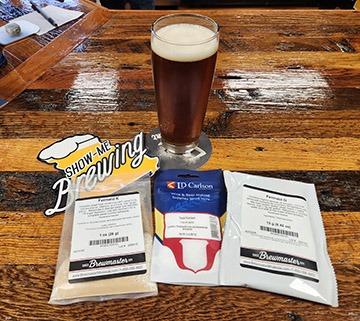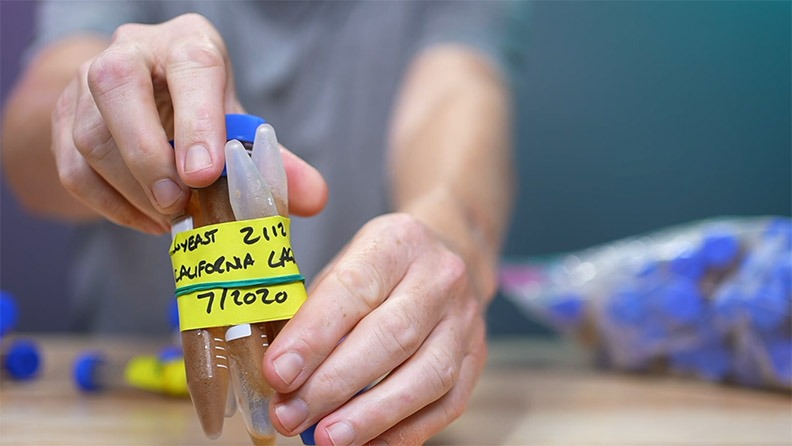Picking the Right Yeast: Tips from the Pros
Grant Johnston, Marin Brewing Co., Larkspur, California
Grant Johnston looks first for a yeast with “great flavor.” When formulating a new beer, he works around the flavor of the yeast he is using, choosing malt and hops that will “meld” with it. Johnston also looks for a yeast strain that is easy to use.
“I want a strain that behaves well, works quickly, and flocculates well,” he says. He chose his current strain by tasting many real ales in England. Eventually he found one that had the yeast character he wanted. Before bringing the strain into the brewery, he homebrewed 12 different ales with it to make sure it could be used in a variety of styles. Many of the ales brewed at Marin Brewing are of fairly high gravity, and the same yeast is used to ferment all of them. That’s why it’s important that the yeast’s fermentation characteristics are consistent across all brewing styles (Johnston also has to increase pitching rates accordingly).
As a homebrewer, Johnston used to propagate the yeast cultures he gathered from the bottom of Sierra Nevada’s bottled ales. When he made the leap into professional brewing, he hoped to find a yeast that emulated the clean, fruity character of the Sierra Nevada products. Marin Brewing started out with a Whitbread dry yeast recommended by the Siebel Institute in Chicago. After deciding the Whitbread yeast was not performing satisfactorily, Johnston consulted Dave Logsdon at Wyeast Labs in Mt. Hood, Oregon.
Logsdon supplied a top-fermenting culture consistent with Marin Brewing’s stable of English-style ales. Johnston used the Wyeast culture for two years, then switched to an English ale strain. He says he likes working with English strains because they ferment quickly, there isn’t much ester production, and the flavor profile is to his liking. (His interest in English beers has led him to travel extensively in the U.K. He recently returned with a not-yet-identified Burton yeast culture).
Any experimentation with yeast cultures is carried out by Johnston in his home with the same five-gallon brew system he started with nine years ago. Marin Brewing Co. is not set up with a lab for yeast microscopy, so there is no cell counting or other technical testing done. Johnston says that he is meticulous about sanitation procedures and although he harvests and repitches his yeast, he never repitches more than 10 generations—the level at which yeast mutations become more apparent. He recommends that homebrewers produce a standard beer to check out yeast strains. He uses a pale ale that contains one crystal malt, Godling or Styrian hops, and the particular yeast strain he is testing. Using a standard formula helps him pick up the nuances of the strain, he says.
Russell Klisch and Jim Surwillo, Lakefront Brewing Company, Milwaukee, Wisconsin
When Russ Klisch decided to start a lager brewery, he knew he wanted to find a yeast that was durable, easy to use, and flavorful. He settled on Schmidt 118, as suggested by the Siebel Institute. According to figures supplied by Siebel, one in three American lager breweries were using this strain. Its characteristics included an ability to ward off bacterial infection, a good flavor profile, and a consistency that allowed it to withstand occasional “hiccups” in the brewery.
Because the Lakefront brewery does not filter its products, good flocculation characteristics were also of great importance. After years of successfully producing all bottom-fermented products, Klisch wanted to expand his stable to include some ales. Intent on finding a fruity, estery yeast, Klisch, like Johnston, contacted Wyeast Labs for their input. He ended up with a London Ale strain for his pale ale. Lakefront eventually introduced a weissbier and now produces nine regular and seasonal beers using three different strains of yeast.
“Proper sanitation,” says Klisch, “is the bottom line.”
Because Lakefront Brewing does not have a robust process for testing yeast, regular tasting of the product is their method of quality control. For homebrewers Klisch suggests research: for a complete understanding of the style of beer you intend to make, consult reliable homebrew suppliers and authoritative publications. Armed with this knowledge, consider the positive and negative flavor characteristics of the style that may be accentuated by the yeast. When setting out to find the right culture, brewers should keep in mind attenuation and flocculation characteristics of the yeast.
“Be bold and experiment. Experimenting with yeast is part of the fun of homebrewing,” says Jim Surwillo.
The final thing he would recommend, Surwillo says, is picking one strain and using it for every brew. He likes to grow yeast from a packet or slant and use it for several brews over a period of many weeks. “That way you get a real feel for the strain,” he says. “Also, you eliminate yeast propagation time after the first brew. You can harvest the yeast from the first brew, store it for a couple of days, and reuse it when it’s time to brew again.”
Steve Nordahl, Frederick Brewing Company, Frederick, Maryland
Steve Nordahl understands how closely homebrewing and professional brewing are related. When he chose an ale yeast strain for the new Frederick Brewing Co. in 1992, it was one he describes as his “personal favorite from homebrewing.” Nordahl calls the strain “user friendly” because it flocculates and attenuates well and produces subtle flavors. That strain is still being used today in addition to several others at Frederick Brewing.
When Nordahl wanted to include a lager beer among their line, he chose Weihenstephan yeast 3470 based on past experience. To produce a traditional weizenbier he, like his fellow brewers, consulted Dave Logsdon at Wyeast Labs. Logsdon recommended two separate yeast strains that are split-batch fermented and then blended. When it came time to brew a doppelbock, Nordahl added yet another yeast strain to the brewery after reading a book on bock beer and deciding that the resident lager strain would not perform true to style.
For professional brewers, says Nordahl, “performance is number one.” He also looks for a flavor that is “different enough to set our products aside from the rest but that doesn’t put our beers too far out there.”
Nordahl admits that he has been spoiled with an extensively outfitted lab and a full-time microbiologist on staff. The brewery also maintains master culture slants in an on-premise yeast bank. Nordahl says he is constantly trying various yeasts. For testing he uses a five-gallon pilot brewery. Most often, however, yeast performance testing is done with sweet wort taken from a full batch of beer. The raw wort is split into four or five carboys that are pitched with different yeasts. Using identical wort under identical conditions creates perfect control test conditions.
Microbiological testing is done randomly on any of the 18 fermenters at the Frederick Brewing Co. On the second day of fermentation for ales and the third day of fermentation for lagers, an H.L.P. Medium test is conducted. This analysis is designed to detect colony growth of two common bacteria strains, lactobacillus and pediococcus. After each fermentation cycle is complete, the yeast is harvested, wild yeast plates are done, cell counts are made, and the healthy yeast is saved for repitching.
Homebrewers near Frederick are fortunate to be on the receiving end of a lot of free yeast. The brewery shares much of its excess yeast with the local homebrewing club, and Nordahl is often on hand at club meetings to answer homebrewers’ questions. Nordahl advises homebrewers to get into liquid yeast for improved flavor and performance. As far as choosing a yeast type, he believes in “using a strain that fits the style being brewed.”
To determine which strains work with which styles, he recommends doing one-gallon test brews with as many yeasts as possible.
What It All Means
It is obvious that some brewers do more extensive testing than others and, likewise, not all brewers have access to the more sophisticated methods of testing. Much the same can be said for homebrewers. One thing is certain: It is important to take advantage of all of the information sources at your disposal. The first plan of attack is to gather brewing publications and other relevant reading material and to digest all the information before proceeding. Networking with your fellow homebrewers is an excellent way to get helpful feedback, including the beer and brewing forums on the Internet.






